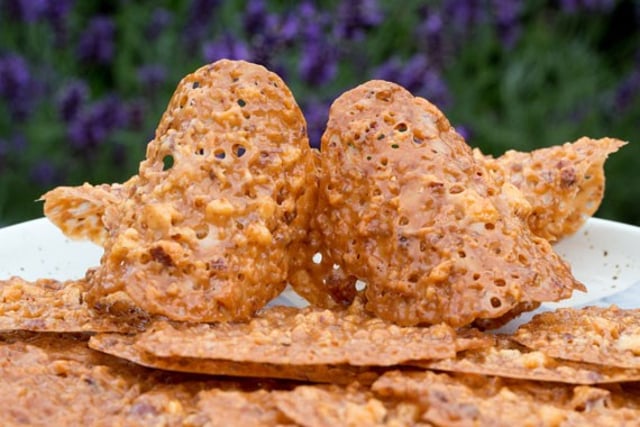Summary
Makes about 18 tuiles (or 'mandelflarn' in Swedish)
Preparation: 15 minutes
Cooking: 30 minutes
Ingredients
50g (1/2 cup*) almonds, shelled weight
50g (4tbsp) butter
50g (4tbsp) caster (superfine) sugar
1 tbsp plain (all-purpose) flour, sifted
1/2 tbsp milk
1 tbsp ljus sirup or any other light coloured sirup
*Don't mix the units!
Method
1. Preheat the oven to 175ºC (350ºF, gas 5, fan 160ºC) and line a large baking tray with baking parchment or silicone paper.
2. Chop the almonds coarsely, using a sharp knife or a food processor.
3. Melt the butter in a saucepan on a low heat. Remove the pan from the heat once the butter has melted.
4. Add the sugar, flour, milk and ljus sirap. Beat until smooth. Stir in the chopped almonds. Replace the pan on the heat and bring to the boil. Simmer for about 1 minute. Reduce the heat to very low, just enough to keep the mixture warm until you have used it all up.
5. Using about 1½ teaspoons per tuile, spoon the mixture on to the prepared baking tray, allowing 6 tuiles per sheet with plenty of space between each one. (Unlike classic French tuile, there is no need to spread the mixture out as it will spread out by itself as it cooks.) Bake for 6- 8 minutes, until the tuiles are golden brown.
6. a) For flat tuiles: allow to cool on the tray for a minute or so and then use a palette knife to transfer them to a board to cool completely.
6. b)For shaped tuiles: allow the tuiles to cool for a minute or so, loosen with a palette knife and then shape them on a greased rolling pin or brandy snap cone moulds, with the upper surface on the outside. When firm, transfer them to cooling rack to cool completely. (If the tuiles cool too much while still on the baking tray and become too brittle to mould, return the tray to the oven for a moment to soften them.)
7. Repeat steps 5-6, until you have used up all the mixture.
8. When the tuiles are cold, store them in an airtight container. For maximum crispness, consume within 24 hours.
Tips
– Swedes normally use ljus sirap (light syrup) when making mandelflarn, but any light coloured syrup, such as golden syrup, can be used instead.
– Allow plenty of space for the mixture to spread, so don’t bake more than 6 at once.
– After baking, the biscuits can be left to cool on a flat surface or shaped on greased rolling pins or on brandy snap cone moulds. (Note: almond tuiles are too brittle to roll into classic ‘cigar’ shapes.)
– If you are shaping the tuiles, bake the mixture in three batches, otherwise some are likely to harden before you get a chance to shape them!
Serving suggestion
Almond tuiles go particularly well with ice cream, such as with bilberry ice cream (wild blueberry ice cream).
Recipe courtesy of John Duxbury, founder and editor of Swedish Food.



 Please whitelist us to continue reading.
Please whitelist us to continue reading.